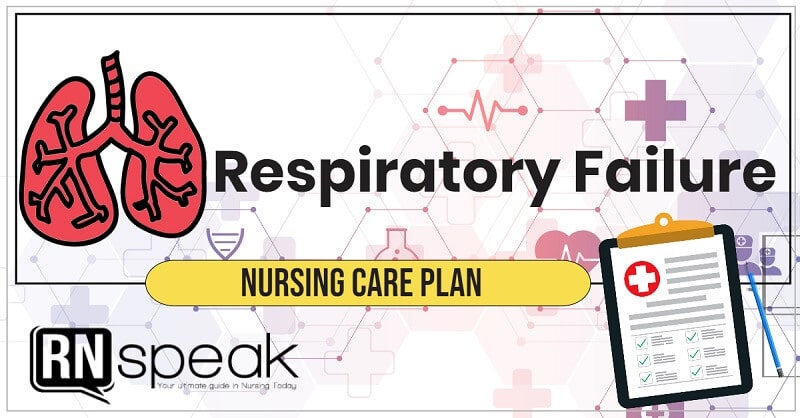Respiratory failure is a syndrome wherein the lungs fail to provide adequate oxygenation or ventilation in the blood. It is a life-threatening deterioration of the gas exchange function of the lungs which leads to hypoxemia and hypercapnia.
Causes
Impaired function of the central nervous system:
- Drug overdose
- Head trauma
- Infection
- Hemorrhage
Neuromuscular dysfunction
- Myasthenia gravis
- Guillain-Barré syndrome
- Spinal cord trauma
Oxygen failure mechanisms leading to acute respiratory failure
- Pneumonia
- COPD
- Acute respiratory distress syndrome
- Pulmonary embolism
Signs and Symptoms
- Dypnea
- Headache
- Confusion
- Tachycardia
- Cyanosis
- Dysrhythmias
- Air hunger
- Diaphoresis
- Restlessness
- Decreased level of consciousness
- Adventitious breath sounds such as crackles and wheezing
Laboratory and diagnostic study findings
- Arterial blood gas studies reveal a Pao2 of less than 80 mm Hg and Paco2 of more than 45 mm Hg; the pH is less than 7.35 (i.e., respiratory acidosis)
- The electrocardiogram shows cardiac arrhythmias.
- Chest radiograph detects lung field changes, depending on causative factors.
Respiratory Failure Nursing Care Plan
Nursing Problem with Cues
Actual/Abnormal Cues:
- Wheezes noted upon assessment
- Tachycardia
- Tachypnea
- Nasal flaring
- Dyspnea
- Restlessness
- Cyanosis
Vital Signs:
Temperature:
37
Pulse rate:
130bpm
Respiratory rate:
37cpm
Blood pressure:
110/70mmHg
Arterial Blood Gas:
PaO₂= 45mmHg
PaCO₂= 67 mmHg
Arterial pH= 7.25
Nursing Diagnosis with Rationale
Ineffective airway clearance related to airway obstruction and bronchospasm
Rationale
Ventilation is the movement of air in and out of the lungs. Normally, air flows freely in order to facilitate oxygenation and gas exchange. In a patient with COPD, airways are obstructed and narrowed leading to alveolar hypoventilation and carbon dioxide retention. As a result, respiratory failure occurs because of the impaired ability of the lungs to provide adequate oxygenation.
Objectives
Long term goal:
After 72 hours of nursing intervention, the client will be able to:
- Achieve airway patency.
- Demonstrate normal oxygen exchange as evidenced by:
-
- Normal respirations
- Clear breath sounds
- Normal ABG levels
Short term goals:
After 1 hour of health teaching, the client will be able to:
- Demonstrate methods to maintain airway patency.
- Participate in the treatment regimen.
Interventions
Independent
Measures to maintain patent airway:
- Observe for signs of respiratory distress;
-
- Increased respiratory rate
- Restlessness
- Use of accessory muscles for breathing
- Prepare appropriate emergency equipment at the bedside.
- Monitor respiratory rate, depth, and breath sound at least every 4 hours.
- Assist the patient in coughing and breathing efforts.
- Provide opportunities for rest; limit activities to the level of respiratory tolerance.
- Position patient in high fowler’s position.
- Instruct in diaphragmatic deep breathing and pursed-lip breathing.
- Conduct health teaching on the following:
-
- Contributing factors to the condition
- Treatment and medications
- Smoking cessation
- Ensuring adequate nutritional intake
- Stress management
Dependent
- Start oxygen therapy.
- Administer medications such as bronchodilators, as prescribed.
- Assist with respiratory treatments:
-
- Intermittent positive pressure breathing
- Incentive spirometer
- Monitor laboratory results:
-
- Chest x-rays
- ABG results
- Pulse oximetry readings.
Rationale for Intervention
- Determines degree/ extent of respiratory distress. A careful assessment provides for early recognition and intervention for problem.
- Impaired respiratory function can be life-threatening.
- Basic indicators of respiratory effort. Monitors progress of the condition.
- Allows for greater lung expansion and ventilation as well as a more effective cough.
- Prevents fatigue.
- Promotes lung expansion.
- Promotes lung expansion and slightly increases pressure in the airways, allowing them to remain open longer.
- Elicits client’s cooperation in the treatment. Provides information for lifestyle changes. Smoking cessation improves pulmonary function.
- Oxygen administration helps correct hypoxemia.
- Dilates the airways; promoting airway circulation.
- Promotes deeper respiration and cough.
- Evaluates progress of the condition as well as the effectiveness of treatment.
References
- Doenges, M.E., Moorhouse, M.F., and Murr, A.C. (2010). Nurse’s Pocket Guide. Philadelphia, Pennsylvania: F.A. Davis Company.
- Newfield S., Hinz, M., Tilley, D., Sridaromont, K., Maramba, P. (2007). Cox’s application of nursing diagnosis: Adult, child, women’s, mental health, gerontic, and home health considerations Philadelphia, Pennsylvania: F.A. Davis Company.
- Silvestri, L. A.(2005). Saunders Comprehensive review for the NCLEX-RN Examination. St. Louis, Mo.: Saunders/Elsevier Inc.
- Smeltzer, S., Bare, B., Hinkle, J. Cheever, K. (2010). Brunner & Suddarth’s Textbook of Medical Surgical Nursing.Wolter Kluwer Health/ Lippincott Williams & Wilkins.








